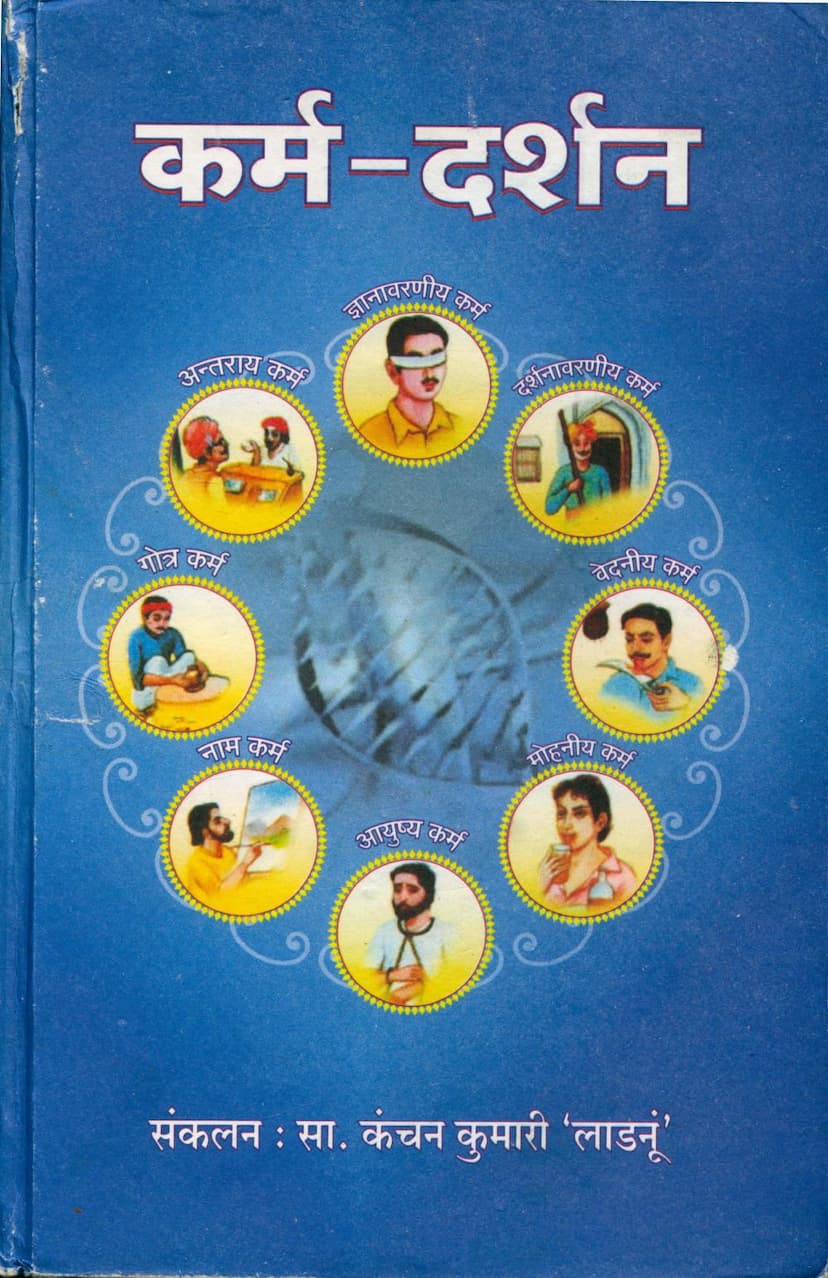Karm Darshan
Added to library: September 2, 2025

Summary
Here's a comprehensive summary of the Jain text "Karm Darshan" by Sadhvi Kanchan Kumari, based on the provided pages:
Title: Karm Darshan (The Philosophy of Karma) Author: Sadhvi Kanchan Kumari ('Ladnun') Publisher: Jain Vishva Bharati Language: Hindi
Overview:
"Karm Darshan" is a detailed exposition of the Jain theory of karma, presented in a question-and-answer format. The book aims to elucidate the fundamental principles of karma in Jainism, making them accessible to a broad audience, from general readers to scholars. The author, inspired by Acharya Tulsi and further encouraged by Acharya Mahapragya and Mahashramani Kankaprabha, has meticulously compiled this knowledge, drawing from various Jain scriptures and texts.
Key Themes and Concepts:
-
The Nature of Karma:
- Karma is defined as subtle material particles (pudgal skandhas) attracted by the soul's good or bad tendencies (purities of mind, speech, and body) and then binding with the soul.
- The soul (Atma) is inherently pure and possesses infinite knowledge, perception, bliss, and power. Karma obscures these innate qualities.
- The soul is eternal in its substance (dravya) but undergoes changes in its states (paryaya), experiencing birth and death.
-
The Eight Karmas: The book systematically explains the eight types of karma, detailing their function, the soul's qualities they obscure or affect, and their underlying causes:
- Jnanaavarniya Karma (Knowledge-obscuring): Obscures the soul's inherent omniscience (Kevalgyan). Its obstruction leads to ignorance. The text links it to the loss of knowledge-related abilities.
- Darshanaavarniya Karma (Perception-obscuring): Obscures the soul's inherent omniperception (Kevaldarshan). Its obstruction leads to a lack of clear perception. This is associated with the senses and the process of seeing and general awareness.
- Vedaniya Karma (Feeling-producing): Responsible for experiences of pleasure (sata) and pain (asata). It binds the soul to worldly sensations and experiences.
- Mohaniya Karma (Delusion-producing): This is a very significant karma that creates delusion, attachment, aversion, and incorrect perceptions (mithyatva). It's divided into Darshan Mohaniya (affecting right faith) and Charitra Mohaniya (affecting right conduct). It's considered a primary cause of karma bondage.
- Aayushya Karma (Lifespan-determining): Determines the duration of life in a particular birth, including the realm of existence (heaven, human, animal, or hell). It binds the soul to a specific lifespan.
- Nama Karma (Body-determining): Responsible for the physical form, species, senses, body-type, colors, smells, tastes, and textures associated with the soul's embodiment. It shapes the individual's physical existence.
- Gotra Karma (Status-determining): Determines the social status or lineage (high or low family) into which the soul is born. It influences how the individual is perceived by others.
- Antaraaya Karma (Obstruction-causing): Hinders the manifestation of the soul's natural powers, such as giving, gaining, enjoying, and spiritual strength (Virya). It creates obstacles in experiencing or utilizing what is rightfully the soul's.
-
Types of Karma:
- Ghati Karma (Destructive Karma): Jnanaavarniya, Darshanaavarniya, Mohaniya, and Antaraaya. These directly obscure the soul's essential qualities.
- Aghati Karma (Non-destructive Karma): Vedaniya, Nama, Gotra, and Aayushya. These affect the soul's conditions and embodiment but do not destroy its inherent nature.
-
Bondage and Release:
- The book details the processes of karma bondage (bandha), its various types (prakriti, sthiti, anubhaga, pradesha bandha), and how karma affects the soul.
- It discusses the states of karma: bandha (bondage), udartana (enhancement), apavartana (diminution), satta (dormancy), udaya (manifestation), udiraṇā (premature manifestation), sankramaṇa (conversion), upaśama (subsidence), nidhitti (fated to be experienced), and nikachita (unalterable).
- Release from karma (nirjara) is achieved through righteous conduct, penance, meditation, and detachment, ultimately leading to liberation (Moksha).
-
Soul's Qualities and Karma's Impact: The text systematically links the eight karmas to the eight fundamental qualities of the soul that they obscure or affect, such as Kevalgyan (omniscience), Kevaldarshan (omniscience), eternal bliss, eternal potency, amurtikapan (formlessness), and agurulaghu-pan (not heavy, not light).
-
Pudgal and Varna (Matter and Classification): It explains the nature of pudgal (matter), its various forms (parmanu, varna, gandha, rasa, sparsha), and how different types of matter (varna, sparsha) are associated with subtle (chatusparshi) and gross (ashtasparshi) pudgals, which in turn relate to different types of karmic influx.
-
Subtle Concepts: The book delves into intricate details like:
- The subtle distinctions between various types of knowledge (Mati, Sruta, Avadhi, Manahparyava, Kevalgyan) and perception (Darshan).
- The classification of karma into pathogenic (savipaki) and non-pathogenic (avipaki).
- The relationship between karma and the different stages of spiritual progress (gunasthanas).
- The role of 'leshyas' (coloring of the soul's disposition) and 'adhyavasaayas' (mental dispositions) in attracting karma.
- The concept of 'karma-sharira' (karmic body) and its relation to the soul.
-
Illustrative Narratives: The book includes numerous stories (kathas) from Jain tradition to illustrate the practical implications of karma, the consequences of actions, and the path to liberation. These stories often highlight the cyclical nature of birth, death, and rebirth driven by karmic residues and the importance of ethical conduct and spiritual discipline.
Structure and Presentation:
- The book follows a structured approach, starting with foundational concepts like the soul and karma and then systematically detailing each of the eight karmas.
- It provides a comprehensive FAQ-style format, answering specific questions about the nuances of karma.
- The inclusion of stories serves as a didactic tool, making complex philosophical concepts relatable and memorable.
- The text emphasizes the scientific and psychological underpinnings of Jain philosophy, as advocated by the author's spiritual guides.
Overall Purpose:
"Karm Darshan" serves as a guide for understanding the Jain perspective on karma, which is central to its philosophy of liberation. It aims to deepen the reader's comprehension of how actions lead to consequences, the intricate workings of the karmic cycle, and ultimately, the path to overcoming karma and achieving spiritual freedom.